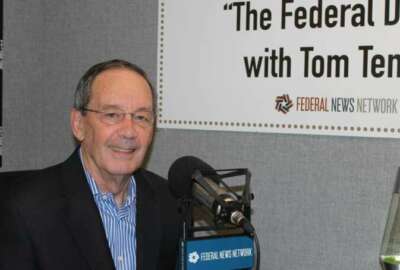
Return of federal workforce hits a rut, what’s the next step?
Agencies and their contractors are starting to ask: What exactly is the future of federal work? SAIC surveyed people across government to get a feel for what...
Best listening experience is on Chrome, Firefox or Safari. Subscribe to Federal Drive’s daily audio interviews on Apple Podcasts or PodcastOne.
You might have noticed that federal agencies are mostly stuck between phases one and two of a hoped-for return to regular work locations. The return seems stuck in neutral. And that’s got agencies, and their contractors, starting to ask: What exactly is the future of federal work? Professional services contractor SAIC surveyed people across government to get a feel for what they’re thinking. For some of the results, Federal Drive with Tom Temin spoke to SAIC’s digital strategy vice president, Mark Forman.
Interview transcript:
Tom Temin: Mark, good to have you on.
Mark Forman: Thanks, Tom.
Tom Temin: So what was the purpose in surveying and who did you survey, first of all?
Mark Forman: The purpose was to figure out how has the response to the pandemic changed the federal government, both in terms of how people are doing work and what they’re concerned and focusing on? And then take a look out into the future, what would be the the longer term what I consider to be the recovery? So the response phase when you first had the pandemic, and you react — and then the recovery phase? How do you kind of pick up the pieces? And where do you go from here longer term?
Tom Temin: And how did you get access to federal people to survey, was a customer list of SAIC?
Mark Forman: No, actually, we used an independent firm. So it was a blind survey by a company called Market Connections, we asked them to focus on three buckets of executives and decision makers. First, the public health community. So this would be agencies like Veterans Affairs, and the operating divisions and Health and Human Services. Secondly, the agencies involved in economic stimulus like Small Business Administration. And third, the other what we call public facing or public agencies, which would include GSA and Social Security Administration. So those three buckets and Market Connection surveyed about 300 decision makers.
Tom Temin: And there’s a lot of detail in the results. And it’s not simply just a will you keep teleworking type of survey. What do you think were the top line findings with respect to what agencies will be doing in the future?
Mark Forman: Well, the first one is that we’ve basically moved from the concept of telework to remote work. So before COVID-19 hit, people were working one to two days a week, telework. And today, in response to the pandemic, certain agencies are even above five days a week, like the health care agencies. And I think that was one of the surprises, we know, they’re working hard, but working remotely more than five days a week, and then into the future, that it’s more than three days. So three to four days a week people now are planning to work remote, which really changes the nature of when you go into federal office building. So that’s the number one surprise. Number two is the survey of what the challenges are going forward in this this next phase, as agencies adjust. And we found that at the top of the list, more than three quarters of respondents are concerned about how do they keep the employees safe that have to come into work, agencies like defense, and how do they prepare the workplace to keep it safe when they want to bring people into the work? And then the second is the economic stimulus? How do they protect against fraud, waste and abuse? How do they make sure that they’re efficiently allocating the money? And the third really, what we thought we’d be higher, was the cybersecurity challenges. I think we’ve all read and heard about the various attacks. That that’s kind of middle of the pack of the top challenges in the survey.
Tom Temin: What does SAIC see as the contractor role in helping agencies cope with this new way of working?
Mark Forman: Well, I think there are a couple that are part of this longer term shifting to the the future where people are basically working remote. One of those is considering that a lot of agencies did very heroic and successful I think you see from the results moving to remote work. But we know there are better ways to do that. And I think the next phase we see improves cybersecurity and cost takeout on creating that secure virtual work environment and allowing you to use the same secure environment, whether you’re on premise or working from the home office, whatever that may be. I think the second one is an IT modernization. And we know that the scale overwhelmed a lot of these legacy systems. I think it’s pretty clear from the survey results that government’s going to look to partner with industry, to not just modernize those systems, but be able to scale up and down. Many things like we’ve talked about for years with the the cloud and the benefits of the cloud, but now, taking advantage of that, as we modernize a lot of these economic systems and financial systems.
Tom Temin: So in other words, the IT modernization goals themselves may have shifted, and what it is agencies need to accomplish with modernization has moved away from data centers and networks snaking through buildings to the almost hub and spoke effect of people being remote with a lot of services in the cloud.
Mark Forman: That’s right, Tom. And I think you know, with my former federal CIO head on, there’s gonna be a lot of change in business processes, whether that leverages RPA and automation to be able to scale to these volumes, because it is so hard to hire a lot of people to scale and you don’t want to scale up and then scale down by hiring and firing. But I think that’s going to be one thing that we’ll see. And then I think it’s always when you have this big of a change that has process technology and people implications, we’ll start to see some modernize business practices as well. And I think the survey points to the fact that those are going to be around fraud, waste, and abuse and efficiency and effectiveness and program management.
Tom Temin: And as far back as when you were with the Office of Management and Budget, and that was during the George W. Bush administration, the government has been trying to over and over again, reduce its real estate footprint. GSA has been trying to do this White House’s have been trying to do this. Do you get the sense that now it really might happen?
Mark Forman: Absolutely. One of the key concerns about leveraging telework was lost productivity and the survey shows that the executives and decision makers were asked around this question saw an increase in productivity to the extent again, it’s notional, they believe that their productivity increased, and we got to trust that that’s a change in attitude towards telework. But again, you know, you look at that what the survey saying, and it’s really a shift from telework to remote work, we’ve overcome a lot of the fears that seemed to be constrained in the past.
Tom Temin: Because the word telework centers or I should say remote work centers proposed and tried quite a number of years ago, just to avoid people having to do the bad commutes into DC, the suburb to Central City model, but those never really caught on. So remote working today still means it sounds like people being separated from one another. Because what’s the difference between going to a big telework or remote working center with lots of people and going to the regular office with lots of people?
Mark Forman: I think that’s right on target, what I have taken away from the survey results is that if you’re going to be an office by yourself during your work, might as well do that at home and avoid all the hassles with the traffic. When you have to come in to collaborate with your colleagues and you can’t do it via online video conferencing using today’s tools, then you’ll see much more secure use of conference facilities, and that may be the office building of the future. It’s a meeting place, as opposed to an office space.
Tom Temin: Interesting. And so what’s your best advice for federal managers — I mean we have a possibly a change in presidential administrations coming. And so it’s going to be falling to I think the standing career workforce to deal with how agencies operate in the future. Maybe Congress will have something to say, but what’s your best advice for planning that we’re not going to come back to the way it was in March 15th of 2020?
Mark Forman: Well, I think number one is to understand what the implications are for the way your program office does its work or your agency does this work. If you’re spending a lot of time on your own, and you need limited interaction with the team, then you should be set up for securely accessing your your data and your applications. And that should be the communication back to the CIOs. By the same token, I think the CIOs should be looking at how to these new technologies, which tend to really favor greater collaboration, secure collaboration, leveraging the cloud and the on premise data stores, what needs to be done to make that more responsive, more secure? And so I think there’s a role for both the CIO teams in terms of how technology is leveraged, and the mission side of the business side of the agencies to look at where are the opportunities for transformation?
Tom Temin: Mark Forman is vice president for digital strategy at SAIC. Thanks so much for joining me.
Mark Forman: Thanks, Tom. It’s good to talk with you.
Copyright © 2025 Federal News Network. All rights reserved. This website is not intended for users located within the European Economic Area.
Tom Temin is host of the Federal Drive and has been providing insight on federal technology and management issues for more than 30 years.
Follow @tteminWFED





